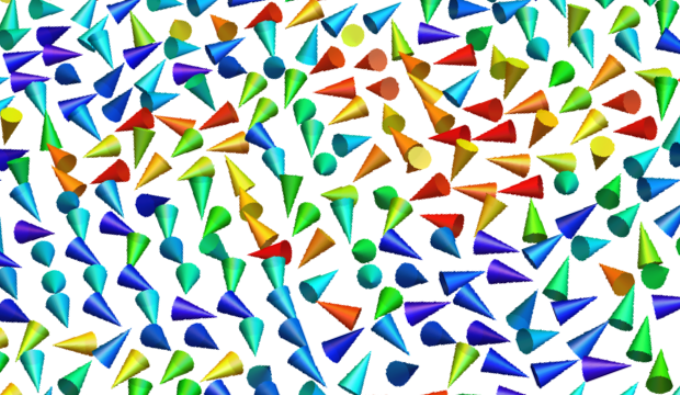Feb 15 2019
Data storage consumes a lot of energy in present-day’s magnetic media. A mixture of unique materials and the coupling between their properties could decrease the energy required to regulate magnetic memories, and so, contributing to a smaller carbon footprint of the IT sector.
 The cones represents the magnetization of the nanoparticles. In the absence of an electric field (strain-free state) the size and separation between particles lead to a random orientation of their magnetization, known as superparamagnetism. (Copyright: HZB)
The cones represents the magnetization of the nanoparticles. In the absence of an electric field (strain-free state) the size and separation between particles lead to a random orientation of their magnetization, known as superparamagnetism. (Copyright: HZB)
Currently, an international team led by HZB has studied the HZB lightsource BESSY II, a new occurrence in iron nanograins: while usually, the magnetic moments of the iron grains are chaotic with respect to each other at ambient temperature, this can be altered by applying an electric field: This field triggers locally a strain on the system resulting in the development of a so-called superferromagnetic ordered state.
Swapping magnetic domains in magnetic memories generally necessitates magnetic fields which are produced by electrical currents, and thus requiring large quantities of electrical power. At present, teams from Spain, France, and Germany have shown the viability of another method at the nanoscale: “We can induce magnetic order on a small region of our sample by employing a small electric field instead of using magnetic fields”, Dr. Sergio Valencia, HZB, highlights.
Ferroelectric substrate with magnetic nanoparticles on top
The samples comprise of a wedge-shaped polycrystalline iron thin film placed on top of a BaTiO3 substrate. BaTiO3 is a common ferroelectric and ferroelastic material: An electric field is able to alter the BaTiO3 lattice and trigger mechanical strain. Examination by electron microscopy exposed that the iron film comprises of minute nanograins (diameter 2.5 nm). At its thin end, the iron film measures less than 0.5 nm in thickness, enabling “low dimensionality” of the nanograins. Given their minute size, the magnetic moments of the iron nanograins are chaotic with respect to each other; this state is called superparamagnetism.
BESSY II: Mapping the magnetic order
At the X-PEEM-Beamline at BESSY II, the researchers examined what occurs with the magnetic order of these nanograins when exposed to a small electric field. “With X-PEEM we can map the magnetic order of the iron grains on a microscopic level and observe how their orientation changes while in-situ applying an electric field”, Dr. Ashima Arora explains, who conducted most of the experiments during her PhD Thesis. Their findings reveal: the electrical field prompted a strain on BaTiO3, this strain was conveyed to the iron nanograins on top of it and previously superparamagnetic areas of the sample swapped to a new state. In this new state, the magnetic moments of the iron grains are all arranged along the same direction, i.e. a collective long-range ferromagnetic order termed as superferromagnetism.
From spintronics to straintronics
The experiments were carried out at a temperature marginally higher than room temperature.
This lets us hope that the phenomenon can be used for the design of new composite materials (consisting of ferroelectric and magnetic nanoparticles) for low-power spin-based storage and logic architectures operating at ambient conditions.
Dr. Sergio Valencia, Researcher, HZB.
Regulating nanoscale magnetic bits in magnetic random access memory devices using electric field triggered strain alone, is also referred to as straintronics. It could pave way for a new, scalable, rapid, and energy-efficient alternative to today’s magnetic memories.